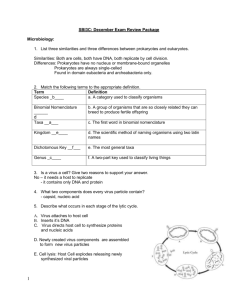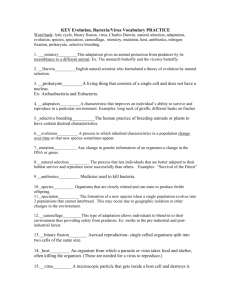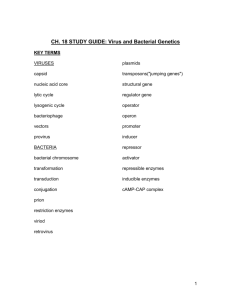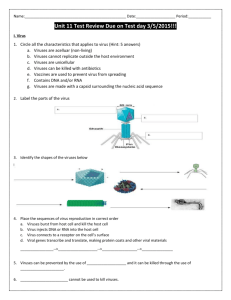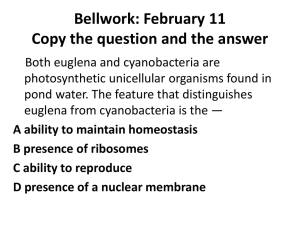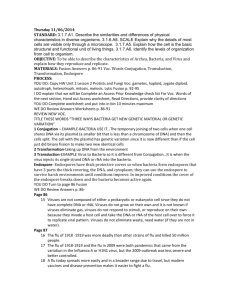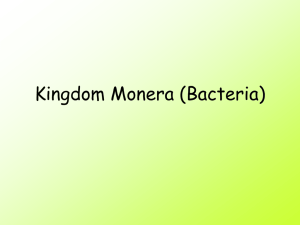Virus and Bacteria Outline & Notes - Biology
advertisement
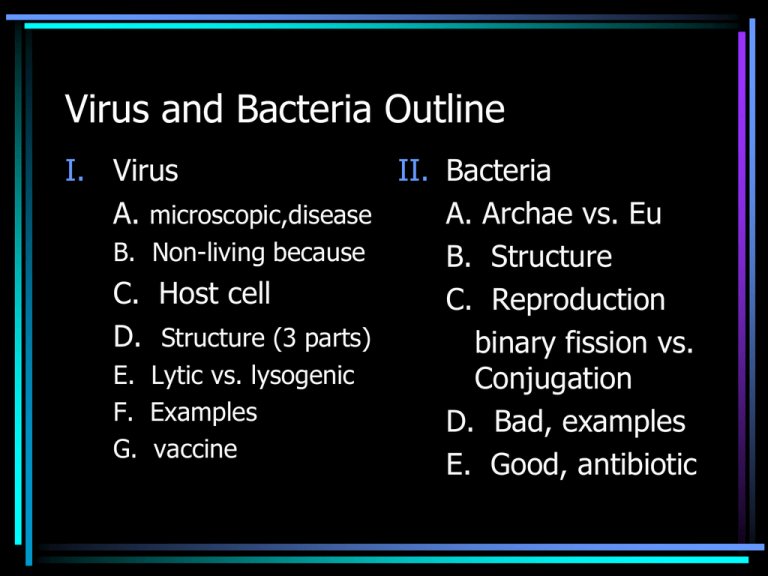
Virus and Bacteria Outline I. Virus II. Bacteria A. microscopic,disease A. Archae vs. Eu B. Non-living because B. Structure C. Host cell C. Reproduction D. Structure (3 parts) binary fission vs. E. Lytic vs. lysogenic Conjugation F. Examples D. Bad, examples G. vaccine E. Good, antibiotic Viruses and Bacteria Notes: Chapter 18 Viruses: • Microscopic particles that invade cells and cause disease • Non-living because they do not grow or develop or carry out respiration; they can only reproduce inside living cells (called a host cell) Structure of a virus: draw and label • Nucleic acid core: either DNA or RNA • Capsid: outer protein coat • Tail fibers: used to attach to host cell Viruses replicate in lytic or lysogenic cycles: (make a copy) • Lytic cycle (active): – Virus attaches to host cell – Injects viral nucleic acid which destroys host’s DNA – New viruses made inside the cell – Host cell pops, releasing virus to infect other cells Lytic Cycle: Lysogenic Cycle: • Viral DNA is joined with the host cell’s DNA (chromosomes) and can be passed on to daughter cells – Virus is present but not active • Explains why some diseases seem to go away only to reappear later and why some diseases don’t show up for many years Lytic and Lysogenic Cycle: Examples of Viruses: • HIV, flu, chicken pox, colds, hepatitis, measles • Can you guess which diseases are caused by lysogenic cycles and lytic cycles? • Vaccinations: – Use weakened form of a virus to create antibodies against the virus 2 minute review with partner 1. What are the 3 parts of a virus? 2. Describe the difference between the lytic and lysogenic cycles. Bacteria:(formerly Kingdom Monera) • Archaebacteria: – – – – Prokaryotes Hetero/autotrophic Live in extreme environments Have DNA sequences similar to eukaryotes and are thought to be their ancestors • Eubacteria: – Prokaryotes – Hetero/autotrophic – Live everywhere Structure of a Bacterial Cell: DNA • Strong cell wall; prevents bursting • DNA in single circular chromosome (no nucleus) • Plasmid: small ring of DNA Shapes of Bacteria: add to notes • Cocci: round shaped • Bacilli: rod shaped • Spirilla: spiral shaped Bacteria replicate (reproduce) by: • Binary Fission: Bacteria reproduce by dividing in half (asexual) • Conjugation: hollow bridge forms b/t cells and genes exchanged (sexualcalled “promiscuity”) The importance of bacteria: (bad) • Cause disease (pathogens) – Ex: strep throat, tetanus, Lyme disease, tooth decay, salmonella, tuberculosis – Fewer deaths from bacterial infections because of sanitation and hygiene (sterilization/pasteurization by heat, disinfectants) The importance of bacteria: (good) • Recycle nutrients through decomposition • Nitrogen fixation: convert nitrogen into a form plants can use • Foods: cheese, yogurt • Medicines: produce antibiotics to kill bacteria by blocking growth /reproduction; insulin 2 minute review with a partner 1. How do bacteria reproduce? 2. Each give one good thing about bacteria. 3. Each give something bad caused by bacteria.
